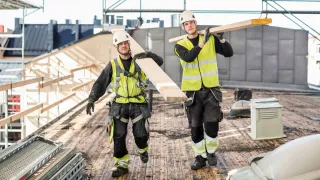Since 2020, quartz dust has been set the binding limit value of 0.1 mg/m3. If the limit value has been exceeded, work must not be continued. Inhalation of fine quartz dust has been recognised to be connected to several occupational diseases, such as silicosis and lung cancer.
The project of the Finnish Institute of Occupational Health, Lotus Demolition Oy and Tapaturva Oy examined being exposed to quartz dust in construction tasks. In the companies that participated in the project, 60 per cent of employees only experienced slight exposure. However, about 10 per cent of the exposure cases were harmful, i.e. over half of the limit value.
The greatest risk of being exposed to quartz dust was in tasks such as sandblasting, demolition of facade elements, diamond drilling, chiseling of floors, and drilling with a drill carriage. The project revealed that tasks such as smoothing of partitions, spreading of railway ballast and road construction included significant exposure. Harmful exposure was detected in all stages of construction.
“Above all, exposure was detected in all situations where no respiratory protective equipment was worn at all or it was worn too soon after the dusty task had been completed. Regardless of the task, the exposure was most dependent on how the work is performed and how the people performing it protect themselves,” says Tapani Tuomi, Project Manager at the Finnish Institute of Occupational Health.
Dust control measures do not replace the use of respirators
In exposure control, the selection and implementation of the dust control measures is important, but so too are the way the tasks are paced in relation to one another and the way good cleaning practices are observed. The correctly timed use and maintenance of appropriate respirators also play a key role.
Many tasks require the use of respirators, even if the best available dust control measures are taken. For example, using water and/or device-specific local exhausts in dust control decreases exposure, but does not eliminate the need to use protective equipment in indoor work. During the project, the use of protective equipment decreased exposure by about half.
“Even in the tasks where excessive exposure was detected, the work could be performed safely when good dust control practices were observed and the respirator appropriate for the task was used. On the other hand, all tasks that included slight exposure also included the possibility of being exposed through room air or by making poor choices in relation to dust control,” says Tuula Räsänen, Researcher at the Finnish Institute of Occupational Health.
The employer must investigate the exposure risks related to the work
The primary duty of the employer is to ensure appropriate dust control on work sites. Assessment and management of the exposure risk are part of safety management in construction.
Employees who have been exposed to quartz in their work must be reported to the so-called ASA register. An employee must be reported to the ASA register if the exposure is at least five per cent of the limit value. The employer is obligated to investigate whether the work exposes workers to quartz dust, and to collect information about the workers who have been exposed to quartz dust in their work. Based on this information, the employer submits the notifications to the ASA register. The ASA register is maintained by the Finnish Institute of Occupational Health.
Medical examinations by the health monitoring service of occupational health care are needed in work where being exposed to quartz can cause the risk of silicosis or lung cancer.
The ‘Exposure to and management of quartz in construction’ research project
- The objective was to identify the tasks in which quartz exposure can be significant and to provide instructions for how to perform these tasks safely. The project also assessed how efficient different dust control measures were in the reduction of exposure.
- Based on the results, construction sector workplaces can develop their operations so that the risk of being exposed to quartz is reduced on work sites.
- Read the final report of the project: Managing quartz exposure in the construction industry (julkari.fi)
- The project prepared a comprehensive instruction package for the management of quartz dust on construction sites (in Finnish): Ohjeet kvartsipölyn hallintaan | Työterveyslaitos (ttl.fi)
- The project was funded by the Finnish Work Environment Fund, the Finnish Construction Trade Union and the Confederation of Finnish Construction Industries RT. Participants in the project included, among others, NCC Finland Oy, CONSTI Oy, Destia Oy, Hartela Oy, Purkupiha Oy and Sandvik Mining Oy.
For more information, please contact
- Project Manager Tapani Tuomi, Finnish Institute of Occupational Health, 040 760 8856, tapani.tuomi [at] ttl.fi (tapani[dot]tuomi[at]ttl[dot]fi)
- Senior Specialist Tuula Räsänen, Finnish Institute of Occupational Health, 040 505 4546, tuula.rasanen [at] ttl.fi (tuula[dot]rasanen[at]ttl[dot]fi)


